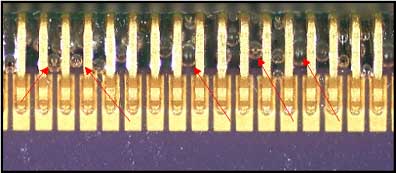|
|
|
|
Bubbles in Conformal Coating |
|
1. PWAs: Bubbles in Conformal Coating under FPGA
Bubbles in the conformal coating underneath the leads of several FPGA's like the one above resulted in the replacement of several parts and reworking of the conformal coating. The reliability concern was stress on the part leads resulting from bubbles when in a vacuum environment. Additional accelerated life tests on the boards in question were required in order to characterize risk. The additional testing resulted in additional time and cost to the project.
Reference :
NASA-STD-8739.1,
11.8 Acceptance/Rejection Criteria for Conformal Coating
Rejection Criteria. The following are some characteristics of unsatisfactory conditions, any of which is cause for rejection:
b. Conformal coating bridges stress relief areas thereby negating stress relief as per paragraph 10.2-4b.
h. Bubbles or bare spots bridging two electrically conductive elements as per Figure 10-2.
i. Bubbles larger than 0.76 mm (0.03 inch) in any dimension as per Figure 10-2.
APPENDIX A
CONFORMAL COATING PROBLEMS
3. Bubbles. Bubbles normally originate from air trapped underneath components and at solder joints. When bubbles bridge uncommon conductors, entrapped moisture or other contaminants may reduce insulation resistance or cause shorts and possible arcing.
Bubbling may be controlled by various means. The angle at which an assembly is dried, cured, or dipped is important in preventing bubble formation. The best angle for spraying conformal coating is usually 45° to the PWA. The drying and cure schedule can also affect bubble formation. Sometimes air cure is needed to permit solvent evaporation; sometimes immediate thermal cure is more desirable because of lower material viscosity caused by higher temperature. Spray coating, being more thinly applied, is not as susceptible to bubbling caused by solvent and air entrapment as are dip coating and brush coating. For thicker coating applications, degassing in a vacuum chamber will remove entrapped air.

|
|
|








